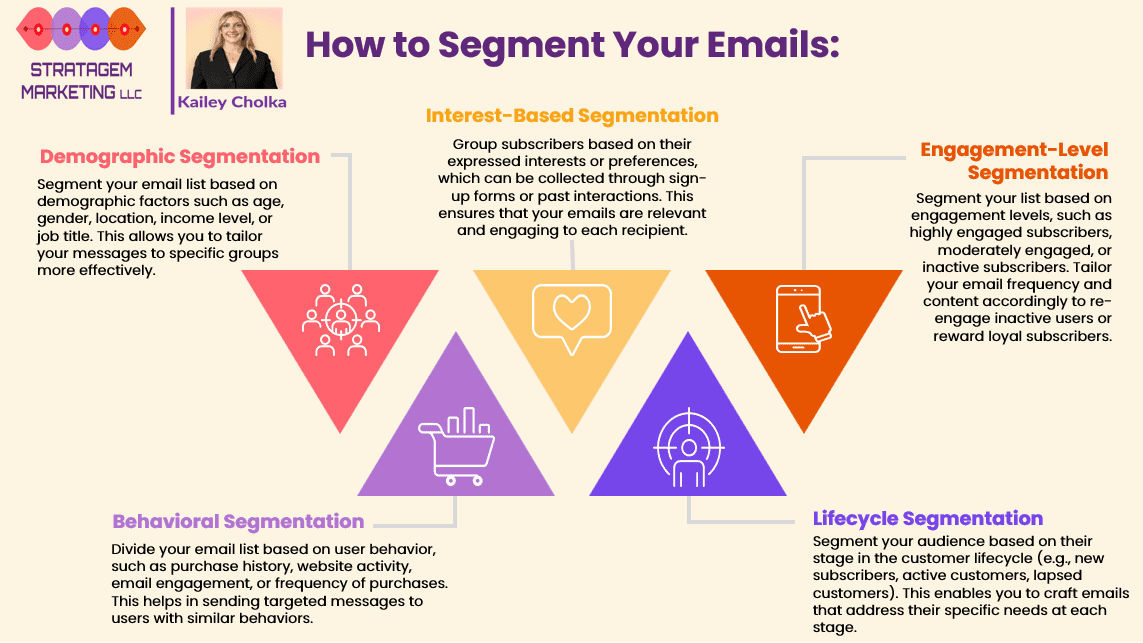Effective Email Segmentation for Better Targeting
Email marketing thrives on personalization and segmentation, which enhance engagement and conversions. By customizing subject lines, content, and offers, businesses can resonate with subscribers. Segmenting audiences by demographics,…
4 min read
Elevate Your Email Marketing with Personalization and Segmentation
In today’s digital age, email marketing remains one of the most powerful tools for small businesses. But to truly stand out in your subscribers’ crowded inboxes, it’s essential to leverage the power of personalization and segmentation. By tailoring your messages to the unique preferences and behaviors of your audience, you can significantly boost engagement, build stronger relationships, and drive conversions. Let’s dive into the importance of email personalization and segmentation and explore how you can effectively implement these strategies.
Email Personalization: Making Every Message Matter
1. Personalized Subject Lines: The subject line is your first impression, and it’s crucial to make it count. Including the recipient’s name or other relevant details in the subject line can grab attention and increase open rates. For example, “Hi [Name], Check Out Our Exclusive Offer for You!” adds a personal touch that resonates with the reader.
2. Tailored Content: Generic content is a thing of the past. To create a meaningful connection with your audience, customize your email content based on the recipient’s interests, past purchases, or browsing behavior. Personalized product recommendations or tailored content that aligns with their preferences can enhance the overall experience and drive engagement.
3. Dynamic Content Blocks: Dynamic content blocks allow you to display different images, text, or calls to action based on the recipient’s data. For instance, you can show different product images based on the recipient’s gender or purchase history. This level of personalization ensures that your emails are relevant and appealing to each recipient.
4. Behavioral Triggers: Behavioral triggers enable you to send automated emails based on specific actions taken by the recipient, such as cart abandonment, purchase confirmation, or browsing certain products. These timely and relevant emails can significantly improve engagement and conversion rates.
5. Personalized Offers and Discounts: Everyone loves a good deal, especially when it’s personalized. Providing exclusive offers or discounts based on the recipient’s previous interactions with your brand can make them feel valued and appreciated. For instance, offer a special discount for loyal customers or a personalized offer for a product category they are interested in.
Email Segmentation: Targeting the Right Audience
1. Demographic Segmentation: Segmenting your email list based on demographic factors such as age, gender, location, income level, or job title allows you to tailor your messages to specific groups more effectively. For example, a clothing retailer might send different promotions to male and female subscribers based on their preferences.
2. Behavioral Segmentation: Divide your email list based on user behavior, such as purchase history, website activity, email engagement, or frequency of purchases. This helps in sending targeted messages to users with similar behaviors, increasing the likelihood of engagement and conversions.
3. Lifecycle Segmentation: Segment your audience based on their stage in the customer lifecycle, such as new subscribers, active customers, or lapsed customers. This enables you to craft emails that address their specific needs at each stage. For example, send a welcome email to new subscribers, and re-engagement emails to inactive customers.
4. Interest-Based Segmentation: Group subscribers based on their expressed interests or preferences, which can be collected through sign-up forms or past interactions. This ensures that your emails are relevant and engaging to each recipient. For instance, a book retailer might send different recommendations to subscribers interested in fiction versus non-fiction.
5. Engagement Level Segmentation: Segment your list based on engagement levels, such as highly engaged subscribers, moderately engaged, or inactive subscribers. Tailor your email frequency and content accordingly to re-engage inactive users or reward loyal subscribers. For example, send exclusive content or offers to your most engaged subscribers.
Why It Matters
Personalization and segmentation are more than just buzzwords; they are proven strategies that can significantly enhance the effectiveness of your email marketing campaigns. By delivering relevant, timely, and personalized content, you can:
- Increase Open Rates: Emails tailored to the recipient’s preferences are more likely to be opened.
- Boost Engagement: Personalized content encourages recipients to interact with your emails.
- Drive Conversions: Targeted offers and recommendations can lead to higher conversion rates.
- Build Loyalty: Showing that you understand and value your subscribers can foster long-term relationships.
Conclusion
Implementing email personalization and segmentation might require some effort and the right tools, but the results are well worth it. By understanding your audience and tailoring your messages to their unique preferences and behaviors, you can elevate your email marketing strategy and achieve greater success.
Ready to take your email marketing to the next level? Contact us to start personalizing and segmenting your emails today, and watch your engagement and conversions soar!


